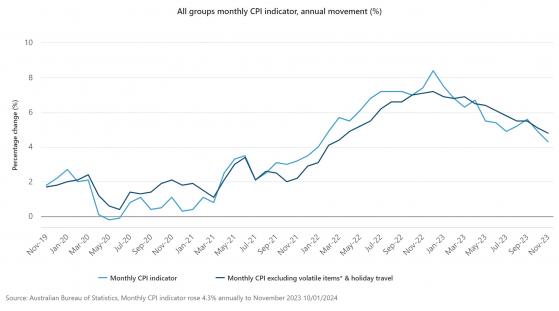In November, Australia witnessed its lowest inflation rate in nearly two years, driven partly by a fall in the price of clothes, appliances and supermarket staples like lamb and beef over the past year.
ABS head of prices statistics Michelle Marquardt said: "This month’s annual increase of 4.3% is down from the 4.9% rise in October and is the smallest annual increase since January 2022.”
This decline in the monthly consumer price index (CPI), which stood below the anticipated 4.5%, strengthens the likelihood that the Reserve Bank of Australia (RBA) will maintain the cash rate at 4.35% in its upcoming February monetary policy decision.
Prior to the release of the CPI, market expectations of a rate hike in February were just 3%. However, some economists predicted the RBA might increase the cash rate to 4.6% due to ongoing inflation concerns, especially in the labour-intensive services sector. This now seems unlikely following the release of the latest numbers.
Excluding volatile items such as fruit, fuel and holiday travel, core inflation also softened, falling to 4.8% from 5.1%.
A return to normal in supply chains and reduced discretionary spending by consumers have contributed to the decline in goods price inflation.
Significant price drops were observed in clothing, footwear, and household furnishings. In contrast, inflation in new home construction rose to 5.5% in November, although it remains below the 21.7% peak reached in July 2022.
The Australian dollar's appreciation, both on a trade-weighted basis and against the US dollar, is bolstering the RBA's efforts to combat inflation. This appreciation is driven by a surge in iron ore prices and expectations of multiple interest rate cuts by the US Federal Reserve.
While the RBA is not expected to ease monetary policy until later in the year, only one rate cut is fully priced into bond futures for the year.
The ABS is set to release its December-quarter CPI report on January 31. This data, coupled with the monthly indicator, will influence the RBA's rate decisions, especially in light of unexpected outcomes.
Rent inflation weighs
The RBA is closely monitoring the services sector, where inflation remains persistent due to increased wage and business costs. Significant price rises in hairdressing, takeaway food, and insurance and financial services reflect these pressures. Additionally, a 7.1% increase in rents over the past year highlights a shortage of rental properties, exacerbated by high migration and limited supply.
The RBA does not anticipate inflation returning to its target range of 2% to 3% until December 2025.
Read more on Proactive Investors AU
